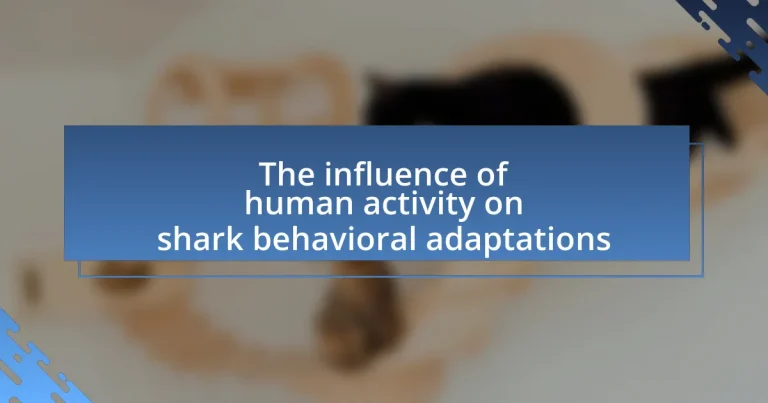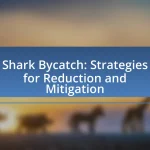Human activity has a profound influence on shark behavioral adaptations, primarily through habitat alteration and changes in food availability. Overfishing leads to shifts in hunting strategies and migratory patterns, while coastal development and pollution disrupt breeding grounds and feeding habitats. These changes can result in increased stress levels, altered social interactions, and reduced reproductive success among shark populations. Understanding these adaptations is crucial for developing effective conservation strategies to mitigate human impacts and ensure the sustainability of shark species and marine ecosystems.
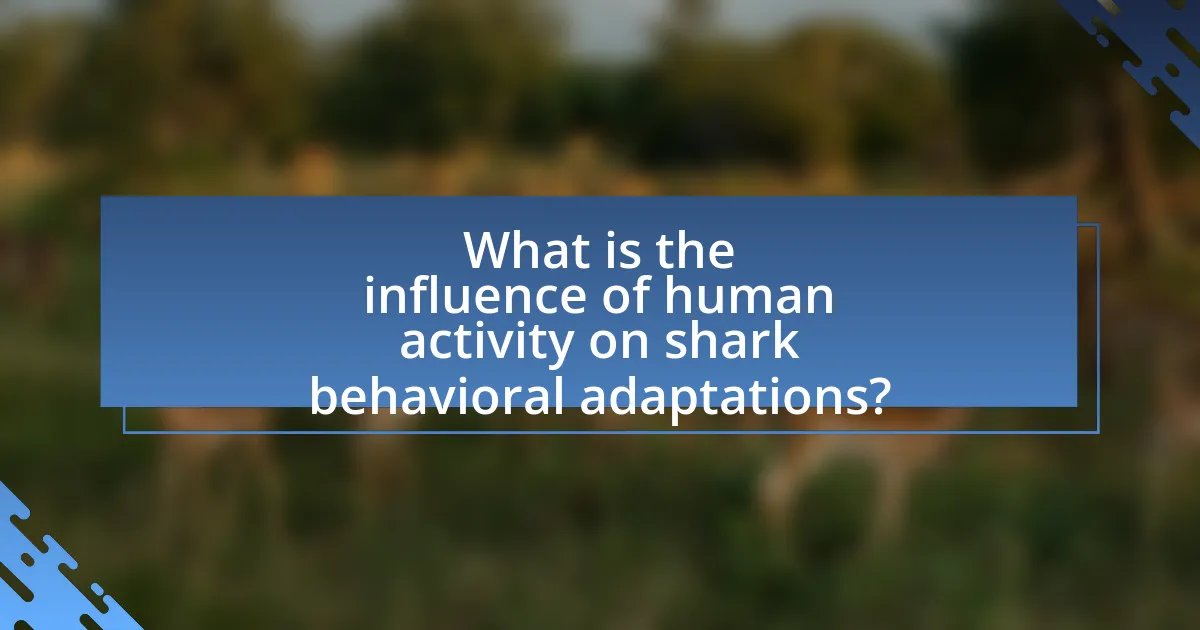
What is the influence of human activity on shark behavioral adaptations?
Human activity significantly influences shark behavioral adaptations by altering their habitats and food sources. For instance, overfishing has led sharks to adapt their hunting strategies and migratory patterns in response to declining prey availability. Research indicates that areas with high fishing pressure see changes in shark behavior, such as increased nocturnal activity and shifts to deeper waters to avoid human interactions. Additionally, habitat degradation from coastal development and pollution forces sharks to modify their behaviors to survive in altered environments. Studies have shown that these adaptations can impact their reproductive success and overall population dynamics, highlighting the profound effects of human actions on shark behavior.
How do human activities impact shark behavior?
Human activities significantly impact shark behavior by altering their natural habitats and food sources. For instance, overfishing reduces prey availability, leading sharks to change their hunting patterns and migrate to new areas in search of food. Additionally, coastal development and pollution can disrupt breeding grounds, causing sharks to avoid certain regions altogether. Research indicates that areas with high human activity, such as fishing and boating, often see a decrease in shark populations and changes in their movement patterns, as sharks tend to avoid these disturbances to reduce stress and increase survival rates.
What specific behaviors in sharks are affected by human presence?
Human presence significantly affects various behaviors in sharks, including feeding patterns, habitat use, and social interactions. For instance, sharks often alter their feeding behavior in response to fishing activities, leading to changes in prey selection and foraging strategies. Research indicates that areas with high human activity, such as coastal regions with fishing or tourism, can result in sharks avoiding these habitats, thereby impacting their natural behavior and ecological roles. Additionally, studies have shown that increased boat traffic can lead to heightened stress levels in sharks, which may affect their reproductive behaviors and social structures.
How do changes in habitat due to human activity influence shark adaptations?
Changes in habitat due to human activity significantly influence shark adaptations by altering their feeding behaviors, reproductive strategies, and migratory patterns. For instance, habitat degradation from coastal development and pollution can lead sharks to adapt by shifting their diets to include more opportunistic prey, as seen in species like the bull shark, which has been observed consuming a wider variety of fish in urbanized areas. Additionally, the loss of breeding grounds due to habitat destruction forces some shark species to adapt their reproductive strategies, such as changing the timing of breeding seasons or seeking alternative locations for pupping. Research indicates that these adaptations are critical for survival in increasingly modified environments, highlighting the resilience of sharks in response to anthropogenic pressures.
Why is understanding shark behavioral adaptations important?
Understanding shark behavioral adaptations is important because it informs conservation efforts and helps mitigate human impacts on shark populations. By studying how sharks adapt their behavior in response to environmental changes, including those caused by human activities such as fishing and habitat destruction, researchers can develop strategies to protect these species. For instance, research has shown that sharks exhibit changes in feeding patterns and migratory routes due to overfishing and habitat degradation, which can lead to population declines. This knowledge is crucial for creating effective management policies that ensure the sustainability of shark populations and the health of marine ecosystems.
What role do sharks play in marine ecosystems?
Sharks play a crucial role in marine ecosystems as apex predators, helping to maintain the balance of marine life. By regulating the populations of prey species, sharks prevent overgrazing of vital habitats such as seagrasses and coral reefs, which are essential for biodiversity. Research indicates that the removal of sharks can lead to an increase in smaller predator populations, resulting in a cascade of negative effects on the ecosystem, including the decline of herbivorous fish that graze on algae. This imbalance can ultimately harm coral reef health and reduce overall marine biodiversity.
How can changes in shark behavior affect marine biodiversity?
Changes in shark behavior can significantly impact marine biodiversity by altering predator-prey dynamics and ecosystem balance. For instance, when sharks exhibit changes in hunting patterns due to human activities like overfishing or habitat degradation, their prey populations, such as smaller fish and marine mammals, may increase unchecked. This can lead to overgrazing of seagrass beds and coral reefs, ultimately diminishing habitat quality and biodiversity. Research indicates that the decline of apex predators like sharks can result in trophic cascades, where the absence of these key species disrupts the entire marine food web, leading to decreased species diversity and ecosystem resilience.
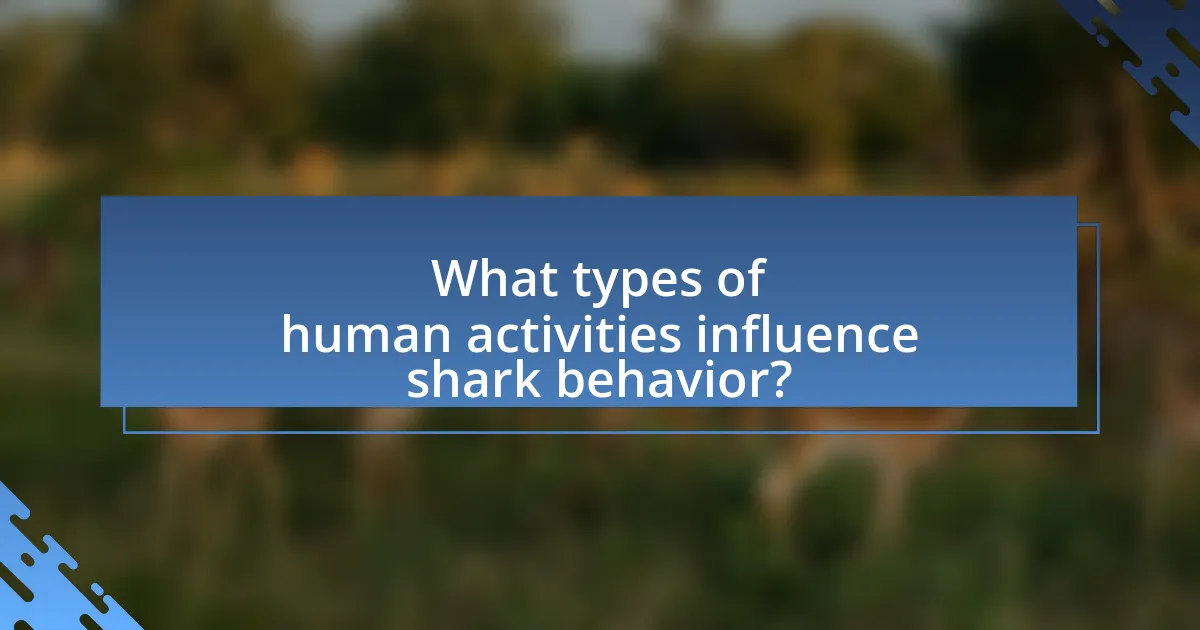
What types of human activities influence shark behavior?
Human activities that influence shark behavior include fishing, habitat destruction, and pollution. Fishing practices, such as commercial and recreational fishing, can lead to overfishing and alter shark populations, affecting their natural behaviors and migration patterns. Habitat destruction, particularly through coastal development and bottom trawling, disrupts essential breeding and feeding grounds, forcing sharks to adapt their behaviors to survive. Pollution, including plastic waste and chemical runoff, can impact the health of marine ecosystems, leading to changes in prey availability and, consequently, shark feeding behaviors. Studies have shown that these activities significantly affect shark populations and their ecological roles, highlighting the need for sustainable practices to mitigate these impacts.
How does fishing impact shark behavioral adaptations?
Fishing significantly impacts shark behavioral adaptations by altering their foraging strategies and habitat use. Sharks often change their movement patterns and feeding behaviors in response to fishing pressure, leading to increased avoidance of areas with high fishing activity. Research indicates that species like the blacktip reef shark exhibit altered hunting techniques and reduced activity levels in regions where fishing is prevalent, as they adapt to minimize encounters with fishermen and fishing gear. This behavioral shift can affect their overall population dynamics and ecological roles within marine ecosystems.
What are the effects of overfishing on shark populations?
Overfishing significantly reduces shark populations, leading to decreased biodiversity and disrupted marine ecosystems. As apex predators, sharks play a crucial role in maintaining the balance of marine life; their decline can result in overpopulation of prey species, which in turn affects the entire food web. Research indicates that global shark populations have declined by over 70% in the last few decades due to overfishing practices, including targeted fishing and bycatch. This decline not only threatens the survival of various shark species but also impacts the health of ocean ecosystems, as evidenced by studies showing that areas with healthy shark populations exhibit greater biodiversity and stability.
How do bycatch and fishing gear affect shark behavior?
Bycatch and fishing gear significantly alter shark behavior by increasing stress and altering their movement patterns. Sharks often exhibit avoidance behavior in areas with high fishing activity, leading to changes in their habitat use and feeding strategies. Research indicates that the presence of fishing gear can cause sharks to become more cautious, impacting their foraging efficiency and social interactions. A study published in the journal “Marine Ecology Progress Series” found that sharks exposed to fishing gear showed increased swimming speeds and altered depth preferences, demonstrating a clear behavioral response to human-induced stressors.
What is the impact of coastal development on shark behavior?
Coastal development significantly alters shark behavior by disrupting their natural habitats and altering prey availability. Research indicates that increased human activity, such as construction and pollution, can lead to changes in shark movement patterns, often pushing them away from traditional hunting grounds. For instance, a study published in the journal “Marine Ecology Progress Series” found that sharks in areas with high levels of coastal development exhibited reduced foraging efficiency and altered migratory routes, likely due to habitat degradation and increased boat traffic. This evidence underscores the direct correlation between coastal development and the behavioral adaptations of sharks in response to changing environmental conditions.
How does habitat loss affect shark migration patterns?
Habitat loss significantly disrupts shark migration patterns by altering the availability of essential habitats such as breeding and feeding grounds. Sharks rely on specific environments for reproduction and sustenance; when these areas are degraded or destroyed due to human activities like coastal development, pollution, and overfishing, their migratory routes can be affected. For instance, research indicates that the decline of seagrass beds and coral reefs, critical habitats for many shark species, leads to decreased shark populations and altered migration behaviors as they search for suitable environments. This disruption can result in increased competition for resources and changes in predator-prey dynamics, ultimately impacting the overall health of marine ecosystems.
What are the consequences of pollution on shark behavior?
Pollution significantly alters shark behavior, primarily by affecting their sensory systems and habitat. Contaminants such as heavy metals and microplastics can impair sharks’ ability to detect prey and navigate their environment, leading to decreased hunting efficiency and altered migratory patterns. Research indicates that exposure to pollutants can disrupt the olfactory senses of sharks, which are crucial for locating food and avoiding predators. For instance, a study published in the journal “Marine Ecology Progress Series” by researchers from the University of Miami found that sharks exposed to chemical pollutants exhibited reduced prey detection capabilities, impacting their survival and reproductive success.
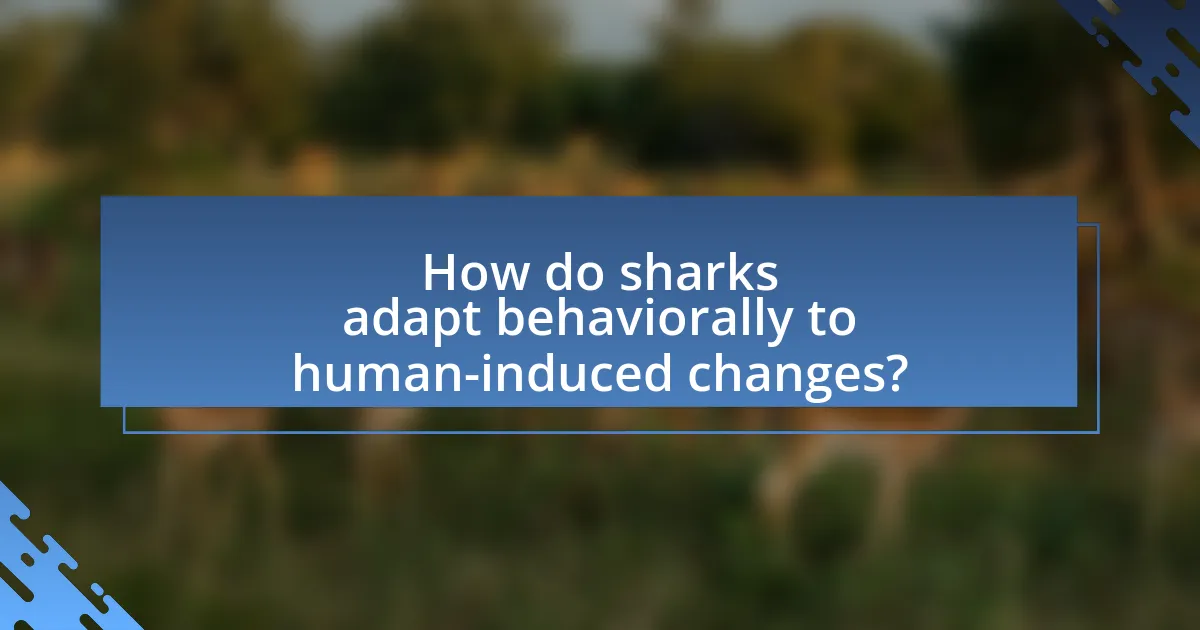
How do sharks adapt behaviorally to human-induced changes?
Sharks adapt behaviorally to human-induced changes primarily by altering their feeding patterns, habitat use, and social interactions. For instance, increased boat traffic and fishing activities have led sharks to modify their hunting strategies, often becoming more nocturnal to avoid human encounters. Research indicates that species like the blacktip reef shark have shifted their foraging behavior in response to the presence of recreational fishing, demonstrating a preference for areas with less human activity. Additionally, studies show that sharks may change their migratory routes to avoid heavily trafficked regions, which can impact their reproductive success and overall population dynamics. These behavioral adaptations are crucial for their survival in increasingly altered marine environments.
What behavioral adaptations have been observed in sharks due to human activity?
Sharks have exhibited behavioral adaptations such as altered feeding patterns and changes in habitat use due to human activity. For instance, increased boat traffic and fishing pressure have led sharks to modify their hunting strategies, often becoming more opportunistic feeders. Research indicates that sharks are increasingly found in shallower waters near coastal areas, likely in response to overfishing of their prey in deeper waters. A study published in the journal “Marine Ecology Progress Series” by Heupel et al. (2015) highlights that these adaptations are a direct response to the pressures exerted by human activities, demonstrating how anthropogenic factors influence shark behavior.
How do sharks modify their hunting strategies in response to human presence?
Sharks modify their hunting strategies in response to human presence by altering their foraging patterns and reducing their activity levels. Research indicates that sharks often become less aggressive and may avoid areas with high human activity, such as popular beaches or diving spots. A study published in the journal “Marine Ecology Progress Series” by Heithaus et al. (2006) found that tiger sharks exhibited decreased hunting success in areas with increased human presence, suggesting that they adapt their behavior to minimize encounters with humans. This behavioral modification helps sharks avoid potential threats and disturbances caused by human activities.
What changes in social behavior have been noted in sharks near populated areas?
Sharks near populated areas exhibit altered social behaviors, including increased boldness and changes in aggregation patterns. Research indicates that these sharks often become more social and congregate in larger groups in response to human activities, such as fishing and tourism. A study published in the journal “Marine Ecology Progress Series” by Heithaus et al. (2006) found that human presence can lead to increased interactions among sharks, as they adapt to the availability of food sources associated with human activities. This behavioral shift highlights the influence of human activity on shark social dynamics and their adaptability to changing environments.
How do these adaptations affect shark survival and reproduction?
Shark adaptations significantly enhance their survival and reproduction by improving their hunting efficiency and reproductive success. For instance, adaptations such as acute sensory systems allow sharks to detect prey from great distances, increasing their chances of successful feeding. Additionally, reproductive adaptations like ovoviviparity, where embryos develop inside the mother and are born live, enhance offspring survival rates in environments with high predation. These adaptations are crucial as they enable sharks to thrive in diverse marine ecosystems, ensuring their continued existence despite environmental changes and human impacts.
What are the long-term implications of behavioral changes on shark populations?
Long-term implications of behavioral changes on shark populations include altered migration patterns, reduced reproductive success, and increased vulnerability to fishing pressures. Behavioral adaptations, often driven by human activities such as overfishing and habitat degradation, can lead sharks to avoid traditional breeding grounds or feeding areas, ultimately affecting population dynamics. For instance, studies have shown that changes in prey availability due to human-induced environmental changes can force sharks to adapt their hunting strategies, which may not be sustainable in the long run. Additionally, altered behaviors can increase the likelihood of sharks entering areas with higher fishing activity, leading to greater mortality rates. These shifts can destabilize ecosystems, as sharks play a crucial role in maintaining the balance of marine life.
How do altered behaviors influence shark reproductive success?
Altered behaviors significantly influence shark reproductive success by affecting mating patterns and habitat selection. For instance, human activities such as fishing, pollution, and habitat destruction can lead to changes in shark behavior, including altered migration routes and reduced courtship displays. Research indicates that these behavioral changes can result in decreased mating opportunities and lower reproductive rates, as seen in species like the blacktip reef shark, where habitat degradation has led to fewer successful breeding events. Consequently, the disruption of natural behaviors directly correlates with diminished reproductive success in shark populations.
What can be done to mitigate the negative impacts of human activity on sharks?
To mitigate the negative impacts of human activity on sharks, implementing effective conservation measures is essential. These measures include establishing marine protected areas (MPAs) that restrict fishing and habitat destruction, which can significantly reduce stress on shark populations. Research indicates that MPAs can lead to increased shark abundance and biodiversity, as seen in the study by Graham et al. (2016) published in “Marine Ecology Progress Series,” which found that protected areas can enhance the recovery of overfished shark species. Additionally, promoting sustainable fishing practices, such as catch-and-release programs and the use of shark-safe gear, can minimize bycatch and ensure that shark populations remain stable. Education and awareness campaigns aimed at reducing shark finning and illegal fishing activities are also crucial, as they can change public perception and behavior towards sharks.
What conservation strategies are effective in protecting shark behavior?
Effective conservation strategies for protecting shark behavior include the establishment of marine protected areas (MPAs), regulations on fishing practices, and public awareness campaigns. Marine protected areas create safe habitats where sharks can thrive without human interference, leading to healthier populations and natural behaviors. Regulations on fishing practices, such as catch limits and bans on shark finning, help reduce overfishing and bycatch, which can disrupt shark behavior and population dynamics. Public awareness campaigns educate communities about the ecological importance of sharks, fostering support for conservation efforts and reducing harmful human activities. These strategies have been shown to improve shark populations and their natural behaviors, as evidenced by studies indicating that MPAs can lead to increased shark abundance and diversity in protected regions.
How can public awareness and education help in shark conservation efforts?
Public awareness and education significantly enhance shark conservation efforts by fostering understanding and support for protective measures. When communities are informed about the ecological role of sharks and the threats they face, such as overfishing and habitat destruction, they are more likely to advocate for sustainable practices. For instance, a study published in the journal “Conservation Biology” found that educational programs increased public support for shark conservation policies by 60%. This increased awareness can lead to reduced demand for shark products and greater participation in conservation initiatives, ultimately contributing to healthier marine ecosystems.
